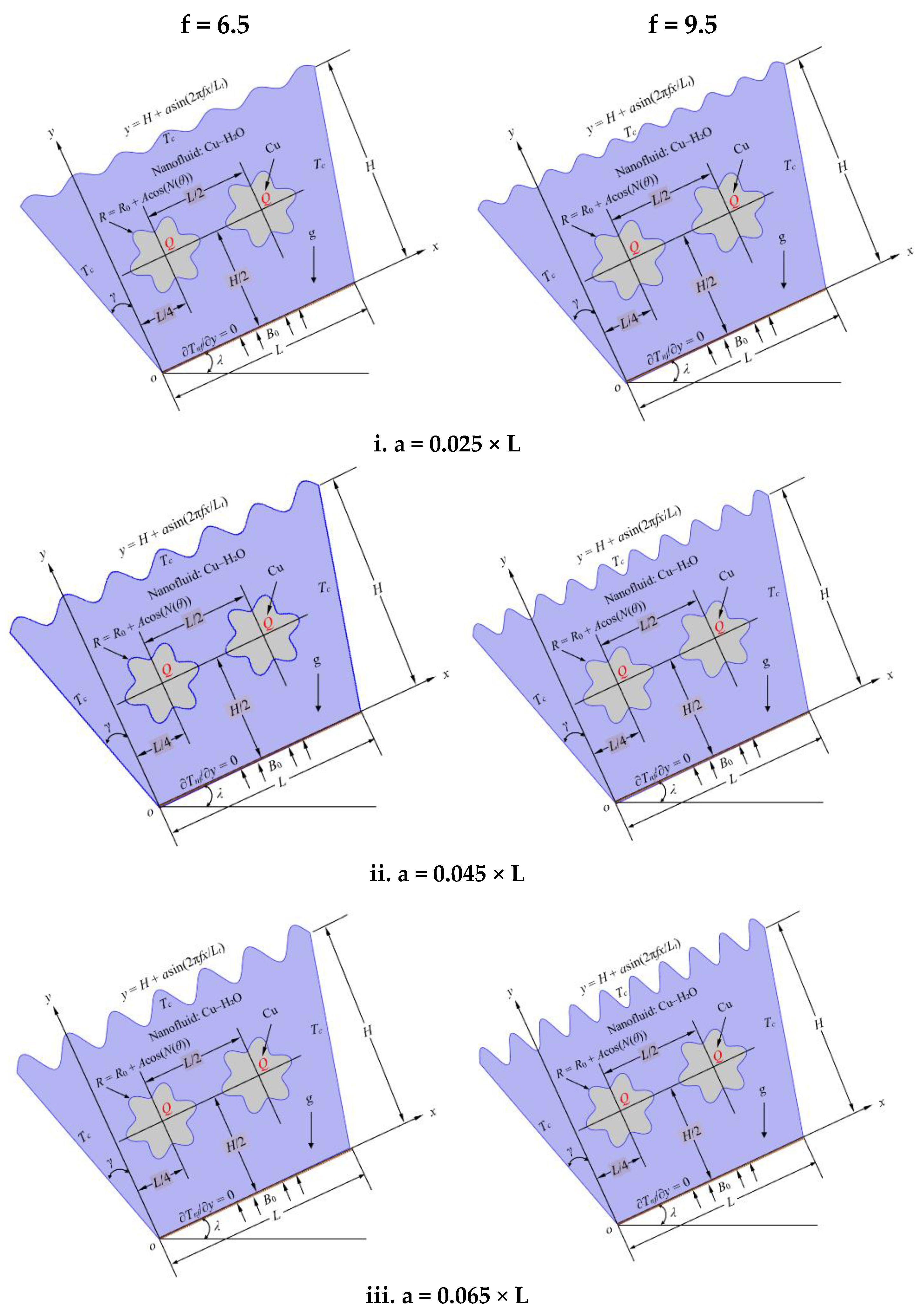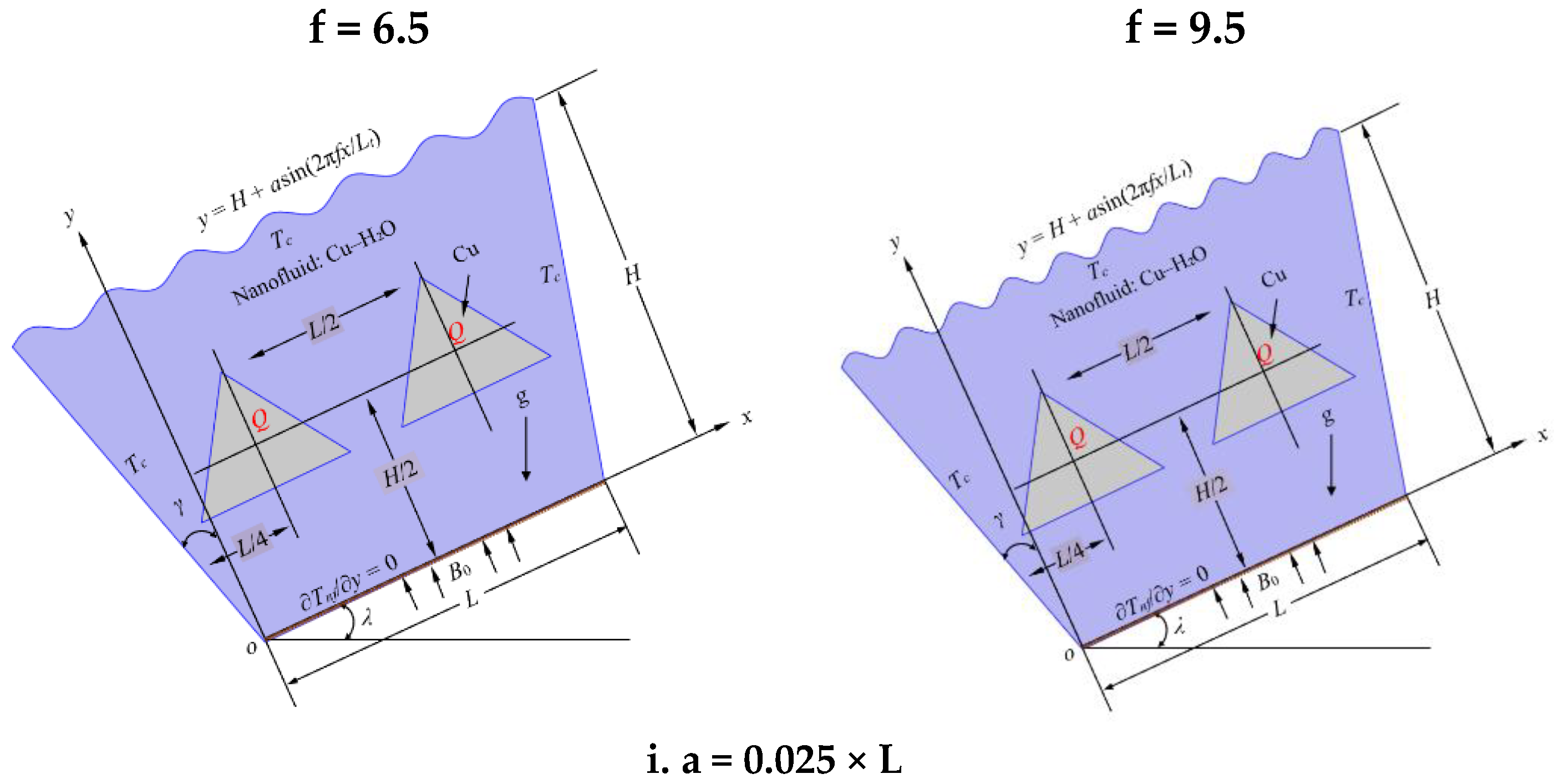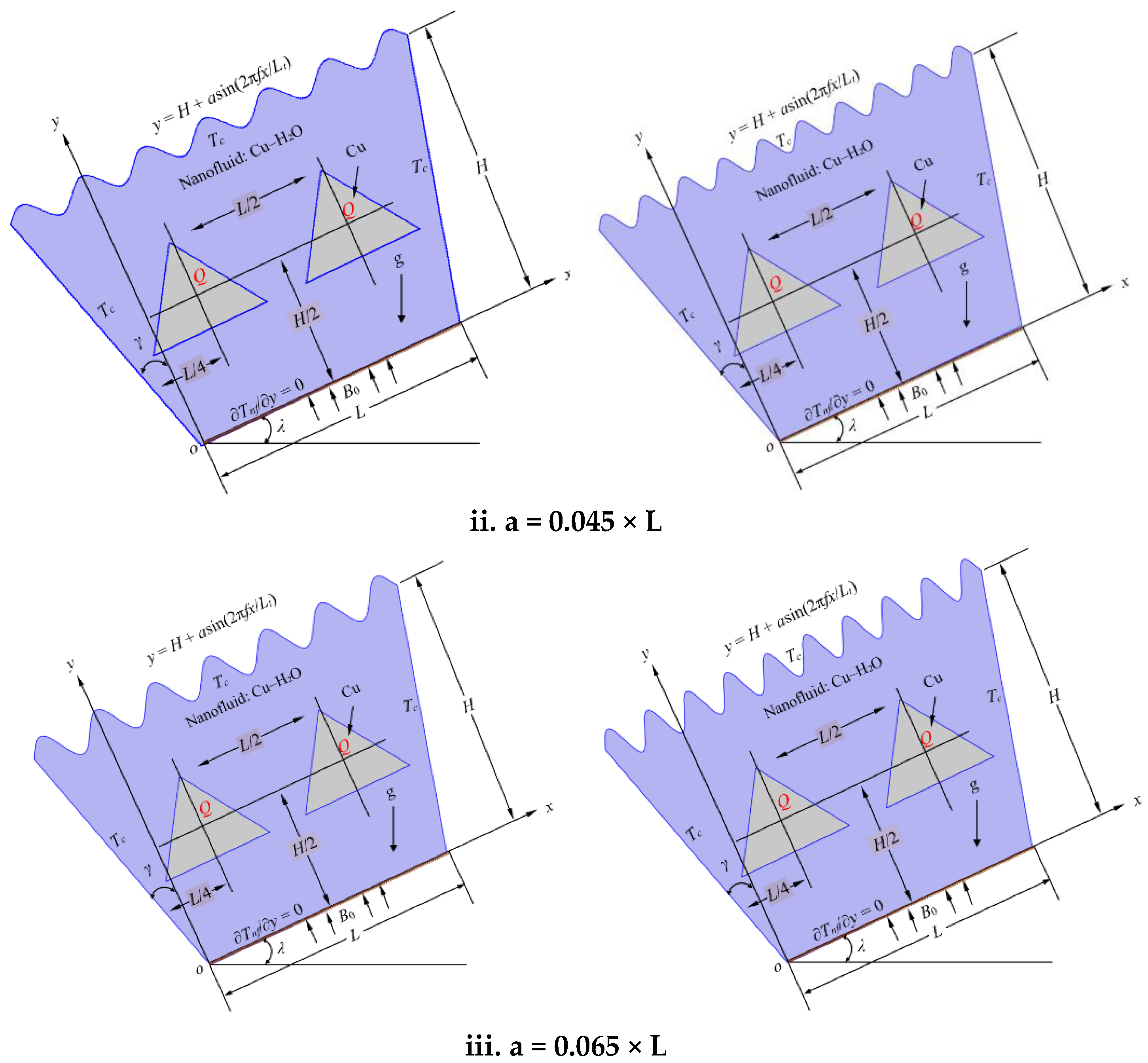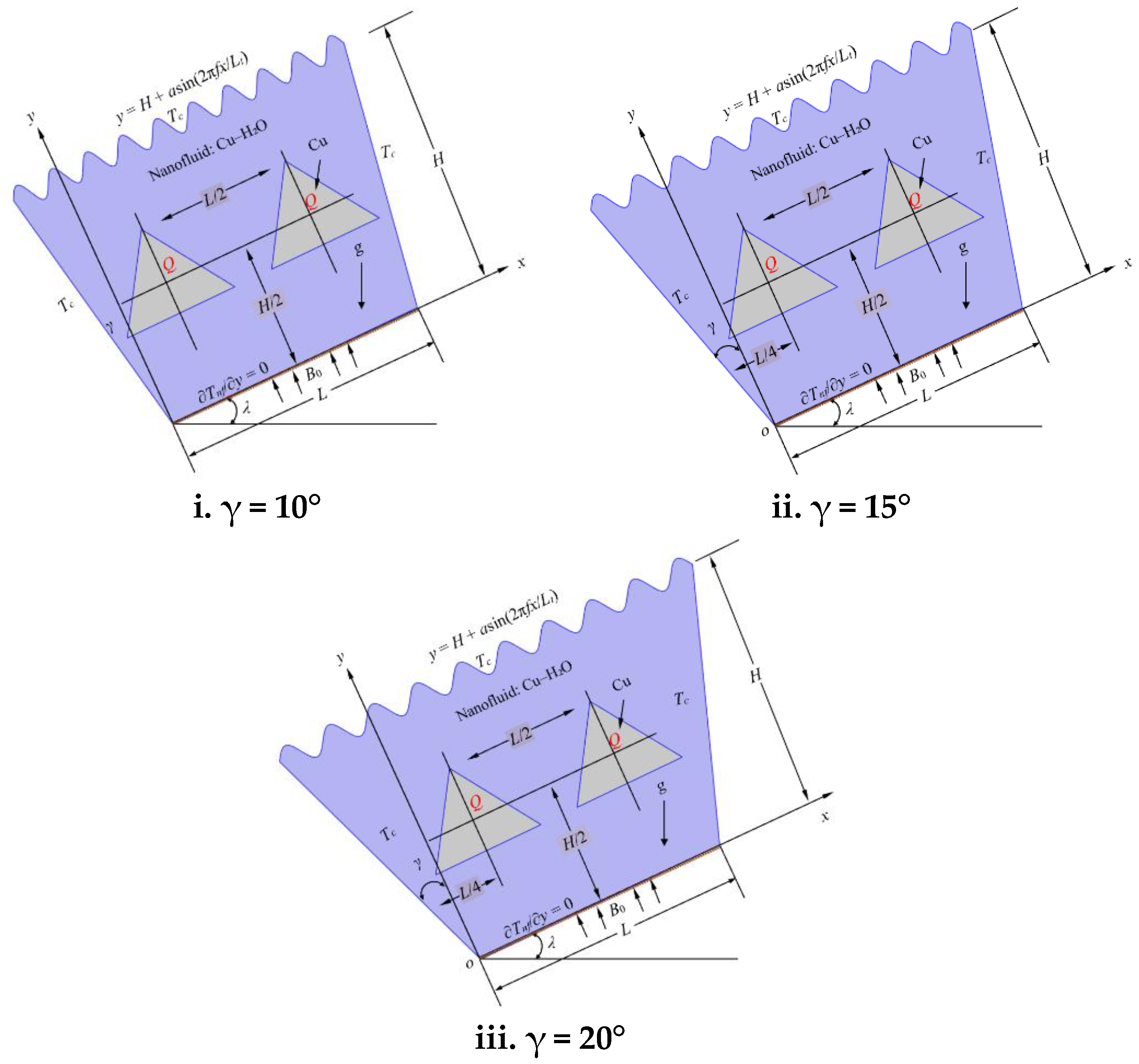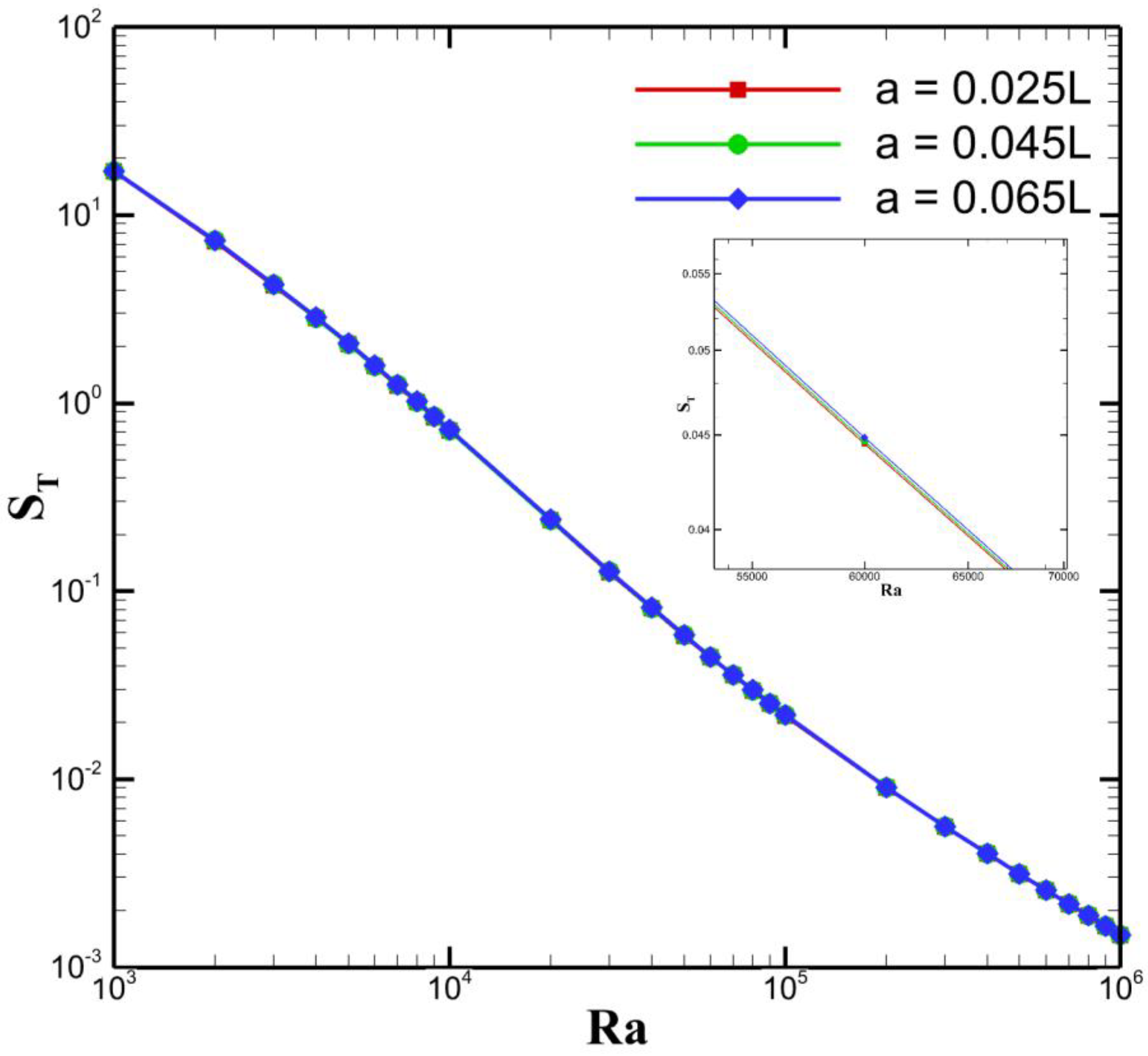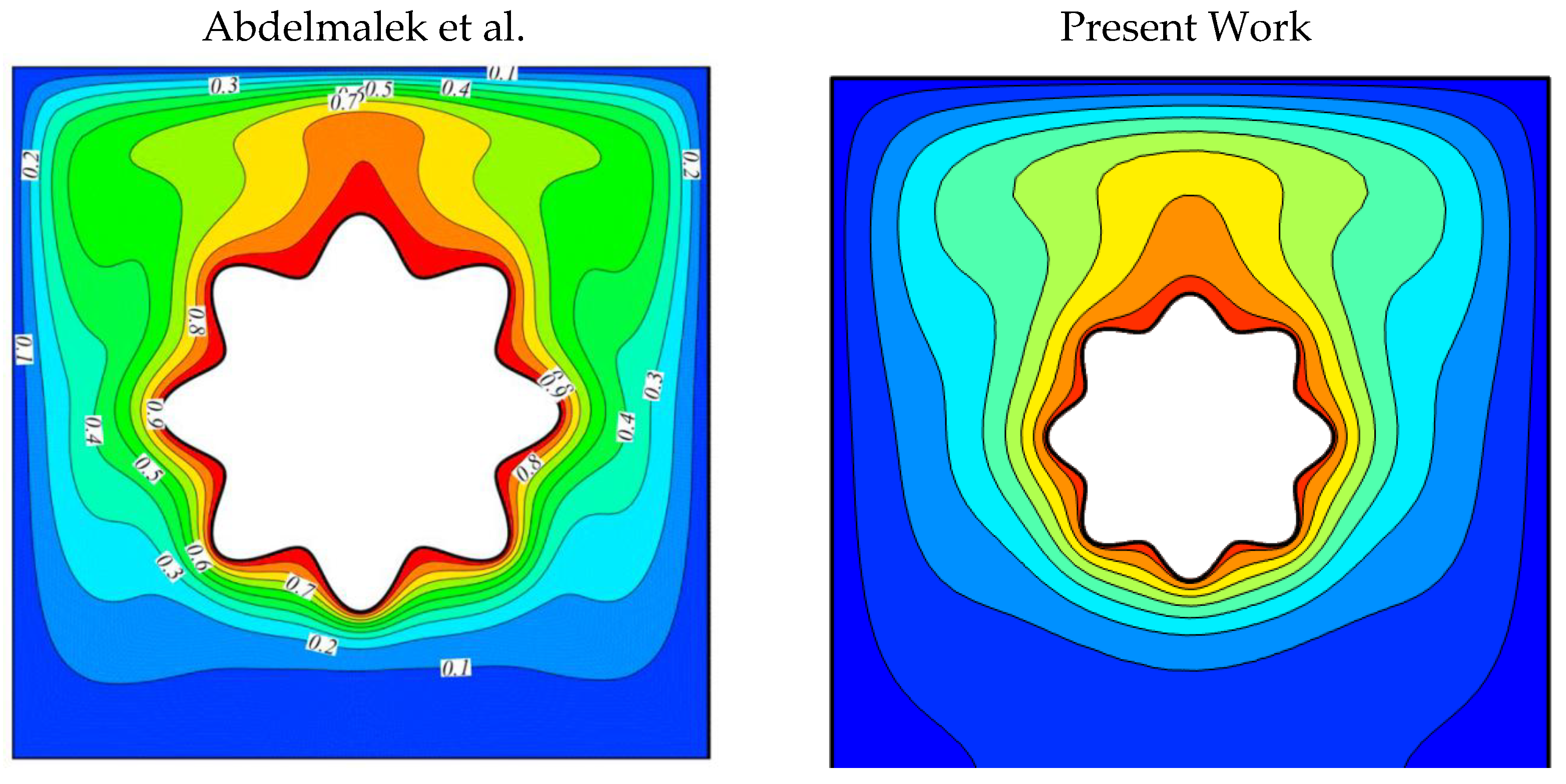1. Introduction
Natural convection within enclosures has long been a central focus of thermal fluid research owing to its widespread applications in geophysical and industrial processes, including electronic cooling, solar energy collection, thermal storage, and biomedical systems [
1,
2]. The emergence of nanofluid base fluids enhanced with high-conductivity nanoparticles such as Cu, Al
2O
3, TiO
2, and Ag has significantly improved the heat transfer characteristics of convective systems by increasing effective thermal conductivity and promoting stronger buoyancy-driven motion [
3,
4,
5,
6]. Among these, Cu–H
2O nanofluid has gained prominence due to its excellent stability, high thermal conductivity, and superior energy transport efficiency, making it a suitable working medium for microscale and compact thermal devices [
7,
8,
9,
10].
Cavity geometry and internal configuration exert substantial influence on natural and mixed convection behavior. Studies have demonstrated that parameters such as internal heat sources [
11,
12,
13], obstacle shape [
14,
15,
16], and boundary heating conditions [
17,
18,
19] critically affect thermal distribution and flow circulation. Research on enclosures with corrugated or wavy walls has shown that geometric undulations effectively disrupt thermal boundary layers, induce secondary eddies, and enhance local convective transport [
20,
21,
22,
23]. Similarly, the inclination of cavity walls modifies buoyancy direction and alters flow symmetry, yielding significant variations in heat transfer rate and entropy generation [
24,
25,
26].
In recent years, the application of magnetic fields in nanofluid-filled cavities has attracted considerable attention. Magnetohydrodynamic (MHD) effects can suppress or enhance convective transport depending on the Hartmann number, magnetic field strength, and orientation [
27,
28,
29,
30,
31]. The Lorentz force generated by magnetic fields influences both velocity and temperature gradients, providing a controllable means to optimize thermal performance. Concurrently, entropy generation has emerged as a key thermodynamic metric for quantifying system irreversibility, enabling the assessment of the trade-off between increased heat transfer and enhanced viscous or Joule dissipation [
32,
33].
A recent investigation reported the behavior of a hybrid MWCNT–Fe
3O
4/water nanofluid convection in a porous wavy trapezoidal enclosure under the influence of MHD [
34]. While that study primarily emphasized the effects of porosity and hybrid nanoparticle interaction, the present research focuses on a non-porous trapezoidal cavity containing Cu–H
2O nanofluid with corrugated walls, base inclination, and internal heat-generating obstacles. This work further extends the understanding of MHD-assisted nanofluid convection by integrating geometric and thermodynamic optimization. A related study on conjugate mixed convection in a lid-driven cavity with internal heat generation and a spinning solid cylinder [
35] provides additional validation context and serves as a benchmark for the present numerical approach.
Despite extensive prior research, the combined influence of wall corrugation, base inclination, and magnetic field interaction on conjugate natural convection and entropy generation within non-porous trapezoidal nanofluid enclosures remains insufficiently explored. The present study addresses this gap by numerically analyzing MHD-assisted Cu–H2O nanofluid convection using the finite element method. The goal is to identify geometric and magnetic configurations that simultaneously enhance heat transfer and minimize entropy production, thereby providing valuable insights for the development of efficient thermal management systems, advanced cooling technologies, and next-generation compact heat exchangers.
2. Materials and Methods
This study focuses on enhancing heat transfer and minimizing entropy generation in a two-dimensional trapezoidal cavity filled with Cu–H2O nanofluid under the influence of a uniform horizontal magnetic field. The cavity features a cold sinusoidally corrugated top wall, an adiabatic inclined base, and two cold slanted side walls. Internally, heat-generating solid obstacles of various shapes are embedded symmetrically. The primary aim is to investigate the effects of top wall corrugation, base inclination angle, and internal obstacle geometry on natural convection and thermodynamic irreversibility in an MHD environment.
The sinusoidal top wall introduces surface complexity, mathematically defined by the function y = H + asin (2πfx/Lt), where a is the amplitude of corrugation and f is the frequency. In this study, three amplitudes (0.025 L, 0.045 L, and 0.065 L) and two frequencies (6.5 and 9.5) were selected to systematically examine the influence of wall corrugation intensity on the overall thermal performance of the enclosure. Lower amplitudes and frequencies correspond to smoother surfaces, which promote stable convection with limited boundary layer disruption. In contrast, higher values generate more pronounced undulations, enhancing local mixing and heat transfer but potentially increasing entropy generation. These selected ranges provide a balanced representation of convective behavior and thermodynamic efficiency.
Figure 1,
Figure 2 and
Figure 3 show the geometries for square, star, and triangle-shaped obstacles, respectively, under various combinations of amplitude and frequency. These shapes were chosen to reflect a range of surface area-to-volume ratios and thermal interaction behaviors.
Figure 4,
Figure 5 and
Figure 6 further illustrate how varying the base angle (γ = 10°, 15°, and 20°) affects the convective flow field and entropy production, particularly when the top wall corrugation is fixed at A = 0.045 L and f = 9.5.
In this study, entropy generation and heat transfer are analyzed for Rayleigh numbers (103–106) and Hartmann numbers (0–50). The selected Rayleigh number range represents the transition from weak to strongly developed natural convection, while the chosen Hartmann numbers capture the shift from buoyancy-dominated to magnetically influenced regimes, enabling a comprehensive assessment of Lorentz force and buoyancy effects on flow behavior, heat transfer, and entropy generation within the cavity.
In this study, Joule heating and viscous dissipation were neglected because their effects are insignificant under laminar natural convection with internal heat-generating obstacles and low-to-moderate Hartmann number ranges, where buoyancy and thermal conduction predominantly govern the energy transport.
The computational model is based on a steady-state, laminar, two-dimensional formulation of the governing equations for fluid flow and heat transfer. The governing set consists of 22 equations, labeled Equations (1)–(22), including the continuity equation, momentum equations in the x and y directions (incorporating the Lorentz force), the energy equations for both fluid and solid regions, and the local entropy generation equation. Entropy generation is calculated from two main contributions: heat transfer irreversibility and fluid friction irreversibility. These equations are non-dimensionalized using characteristic scales for length, temperature, and velocity, and the magnetic field effect is quantified using the Hartmann number.
Boundary conditions for the model are detailed in
Table 1. The combined thermal and fluid boundary conditions ensure realistic heat exchange between solid blocks and the surrounding nanofluid. Thermophysical properties used in the model are presented in
Table 2. The effective properties of the Cu–H
2O nanofluid are calculated using established correlations that account for particle volume fraction and base fluid characteristics. The selection of Cu nanoparticles is motivated by their high thermal conductivity, which is expected to significantly improve the overall heat transfer rate in the cavity.
Here,
u and
v denote velocity components in the
x- and
y-directions, respectively, and
p and
T represent pressure and temperature, respectively. The fluid properties are mass density (
ρ), thermal conductivity (
k), specific heat at constant pressure (
Cp), volumetric thermal expansion coefficient (
β), and electrical conductivity (
σ).
Entropy generation reflects the loss of energy due to irreversible effects, such as heat transfer, friction, and MHD forces. In buoyancy-driven MHD flow, entropy is generated through heat transfer, viscous dissipation, and magnetic fields. The local entropy generation due to heat transfer (
) in solid and fluid domains, volumetric entropy production due to viscous flow dissipation (
), and external magnetic effects (
) can be described using the following formulas:
To get the non-dimensional governing equations, the following scales are used:
Now, the Non-Dimensional governing equations are:
The thermal behavior of the chamber under different operating conditions is assessed by analyzing the Nusselt number (
Nu) of the heated strips and the average fluid temperature (
Θav) inside the domain. The definitions of these quantities are as follows:
The total entropy generation, expressed as a dimensionless quantity, can be obtained using the following expression:
where
A represents the surface area of the computational domain.
In this study, the thermo-physical properties (
Table 2) of the Cu–H
2O nanofluid are considered constant at the mean temperature
. The temperature variation within the cavity is relatively small, so changes in viscosity and thermal conductivity are negligible. This approach is consistent with previous laminar nanofluid convection studies [
8,
19], which have shown that constant properties provide accurate predictions of heat transfer and entropy generation behavior. Furthermore, the influence of nanoparticles on the electrical conductivity of the Cu–H
2O nanofluid was not explicitly modeled, as the variations in this property are negligible within the studied temperature range. The relations defining the effective thermo-physical properties of the nanofluid have been adopted from established models.
Numerical simulation is conducted using the finite element method (FEM). A structured and refined mesh is generated, with higher density near the corrugated top wall, internal obstacles, and boundary layers to ensure solution accuracy. The Galerkin method is employed to discretize the governing equations. A convergence criterion is set such that residuals for all governing equations fall below 10−6. The numerical model is validated through mesh independence and comparison with benchmark results, as discussed in the next section.
This modeling approach allows for a detailed parametric study of how geometric modifications (corrugation amplitude and frequency, base inclination, and obstacle shape) and electromagnetic forces interact to influence convective flow, heat transfer enhancement, and entropy generation inside nanofluid-filled enclosures.
4. Discussion
The present numerical investigation has been validated through a direct comparison with the benchmark study of Abdelmalek et al. [
19], where natural convection of nanofluids in enclosures with star-shaped obstacles was considered.
Figure 13 shows the isotherm distributions at Ra = 10
4, N = 8, A = 0.15, and ϕ = 2%. The comparison demonstrates close similarity in the thermal plume development and boundary layer structure near the obstacle surface, confirming that the present model reliably reproduces the essential flow and thermal features reported previously. This agreement is further substantiated by
Table 15, where the Nusselt numbers predicted in the current work deviate by less than 1.5% from Abdelmalek et al. [
19] across the examined Rayleigh number range (Ra = 10
3–10
6). Such a low deviation validates both the governing equations and the numerical implementation used in this study.
From a broader perspective, the findings align with the general consensus in nanofluid convection research that the inclusion of solid nanoparticles enhances effective thermal conductivity, thereby promoting convective heat transfer. As seen in
Table 15, the Nusselt number increases significantly with Rayleigh number, consistent with buoyancy-driven convection intensification at higher thermal gradients.
The present study extends these results by systematically examining how obstacle geometry, corrugation amplitude, frequency, and base inclination can be tuned to achieve both heat transfer enhancement and entropy minimization. Unlike Abdelmalek et al. [
19], who primarily addressed nanofluid natural convection in smooth-walled enclosures, the current analysis highlights the interplay between obstacle-induced flow disturbances and magnetic field suppression in controlling system performance.
To further ensure the reliability and accuracy of the numerical model, an additional validation was performed against the benchmark results of Mahmud et al. [
35], who studied conjugate mixed convection in a lid-driven cavity containing a rotating solid cylinder. As shown in
Figure 14, the streamline patterns from the present simulation closely match the reference results for
,
, and
, demonstrating similar vortex structures and flow circulation behavior. This strong agreement verifies the precision and stability of the current finite element formulation, enhancing confidence in the adopted numerical scheme for modeling MHD-assisted Cu–H
2O nanofluid convection.
The implications of these findings are significant for thermal management systems where optimizing both energy efficiency and irreversibility reduction is crucial. Square obstacles consistently demonstrated a favorable balance between heat transfer enhancement and lower entropy generation, indicating their potential for practical applications in heat exchangers, electronic cooling, and solar thermal collectors. In contrast, star-shaped obstacles, although geometrically effective at disturbing flow, exhibited excessive entropy production, reducing their thermal efficiency. Triangular obstacles provided moderate improvements, but at the expense of higher irreversibility. This distinction in performance underscores the importance of obstacle geometry selection in engineering applications.
Future research should expand on these findings by incorporating more complex boundary conditions, such as oscillatory heating, non-uniform wall temperature distributions, or porous media filling. Additionally, extending the analysis to hybrid nanofluids (e.g., Cu–Al2O3/H2O) and considering turbulent flow regimes would further enhance the practical relevance of this study. Experimental validation using advanced visualization and thermal imaging techniques would also strengthen confidence in the predictive capabilities of the present numerical model. Finally, exploring optimization frameworks that couple geometry, magnetic field intensity, and nanoparticle concentration could provide a pathway toward real-time adaptive thermal management systems.
The present work is valid and consistent with established literature, while also offering novel insights into corrugation and inclination effects under magnetohydrodynamic conditions. The outcomes reinforce the applicability of nanofluid convection control in advanced thermal engineering applications and set a foundation for future explorations into more intricate and realistic configurations.

